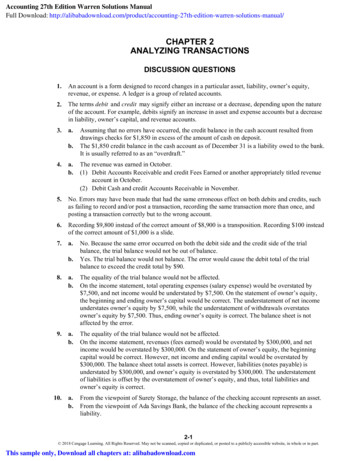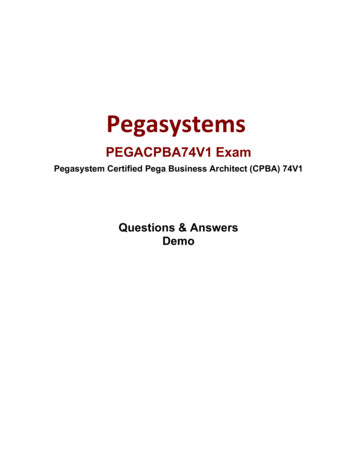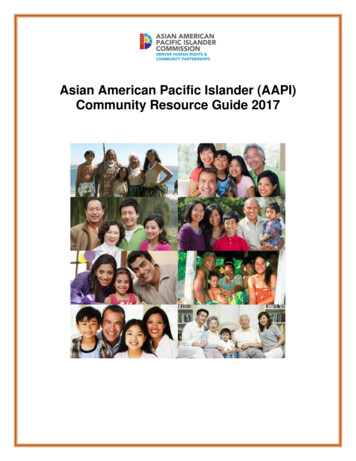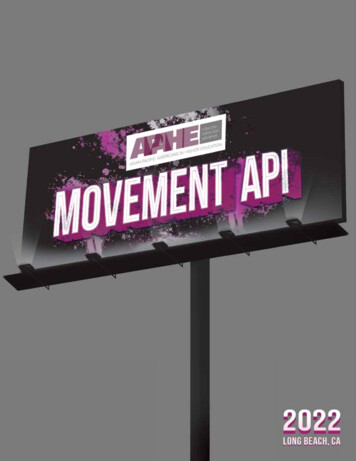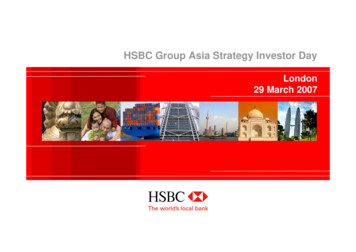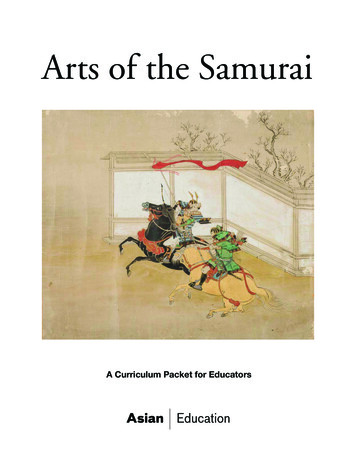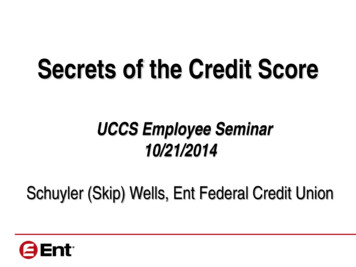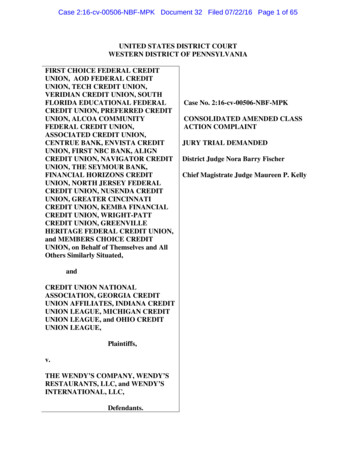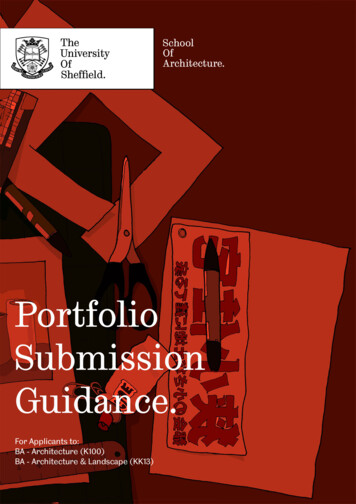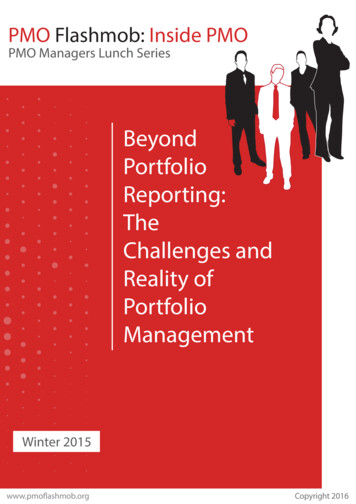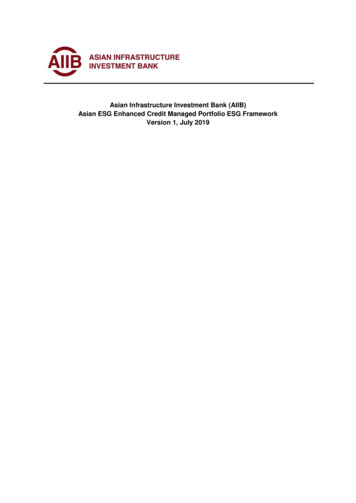
Transcription
Asian Infrastructure Investment Bank (AIIB)Asian ESG Enhanced Credit Managed Portfolio ESG FrameworkVersion 1, July 2019
I.Introduction.3II.ESG Investment Process .3Pre-InvestmentStep 1: Exclusionary Screening . 3Step 2: ESG Assessment. 4Post-InvestmentStep 3: Engagement with Issuers. 5Step 4: Monitoring and Reporting. 5ESG Focus List and Escalation Process .5Reporting .6III. Sustainable Capital Markets Initiative (SCMI) .7Annex 1. Guidelines for AIIB’s ESG Focus List and Escalation Process.9
I.IntroductionInstitutional investors are a key part of the solution to finance Asia’s infrastructure investmentneeds over the coming decades. Additionally, integrating Environmental, Social and Governance(ESG) standards into capital markets in Emerging Asia will be important in achieving long-termsustainable development goals. This Project aims to develop debt capital markets forinfrastructure in Emerging Asia with a strong ESG rationale.The Project consists of two components:(i)Development of an Asia ESG Enhanced Credit Managed Portfolio of USD500 millionthat comprises corporate bonds in Asian infrastructure and other productive sectors.(ii)Launch of a Sustainable Capital Markets Initiative in partnership with the appointedAsset Manager to catalyze ESG investing strategies and build capacity with marketparticipants in Emerging Asia.A key objective of the Project is to catalyze ESG strategies throughout the debt capital market,and the most effective way to do this is through demonstration of an AIIB ESG Framework thatis consistent with the spirit and vision of AIIB’s Environmental and Social Framework.II.ESG Investment ProcessIn general, the ESG investment process includes the following steps:Pre-InvestmentStep 1: Exclusionary ScreeningExclusionary screening can be broken down as follows:1. Country and Sector Requirements.2. Issuers listed on AIIB’s Debarment List.3. Exclusion based on internal socially responsible investment (SRI) score and reputational risk.4. AIIB Environmental and Social Exclusion List, which is captured as product-basedexclusions or as Norms-based exclusions.Product-based exclusionsa.Production of, or trade in, weapons and munitions, including paramilitarymaterials. The Asset Manager will not invest in issuers which derive more than 10percent of their turnover from the manufacture or sale of conventional weapons, orweapon systems.b.Production of, or trade in, alcoholic beverages. The Asset Manager will not3
invest in issuers which derive over 10 percent of their annual turnover from theproduction and/or sale of alcoholic beverages.c.Production of, or trade in, tobacco. The Asset Manager will not invest in issuerswhich make over 10 percent of their gross annual turnover from the productionand/or sale of tobacco products.d.Gambling, casinos and equivalent enterprises. The Asset Manager will avoidinvesting in issuers which derive more than 10 percent of their annual turnover frombetting or gambling operations and/or from supplying gambling equipment.e.Production of, or trade in of unbonded asbestos fibers. The Asset Manager willavoid investing in issuers which derive more than 10 percent of their annualturnover from production of, or sale of, unbonded asbestos fibers.Norms-based ExclusionsNorms-based Exclusions are defined as violations of widely accepted internationalstandards related to environmental, social and governance aspects which aredetermined by AIIB.1 When it comes to Norms-based Exclusions, it is both difficult toobtain information and to assess what qualifies for exclusion. Therefore, AIIB will use afour-step ESG Focus List and escalation process to identify companies that should befurther assessed as further described in the Guidelines for AIIB’s ESG Focus List andEscalation Process (see also Step 4: Monitoring and Reporting; Annex 1: Guidelines forAIIB’s ESG Focus List and Escalation Process).Step 2: ESG AssessmentAll holdings will go through a full and complete research process resulting in the preparation of abriefing note that includes both fundamental credit analysis and ESG assessment. Dependingon the level of ESG information available, this may include:Controversies ScreeningControversies screening using third-party data services.Internal SRI ScoreA proprietary SRI score that provides an assessment of the issuer’s exposure and performanceand reflects in-house analysis of third party ESG data.Internal ESG Risk ScoreAn internal ESG risk score that reflects the potential for ESG risks to lead to financial impacts.See “Environmental and Social Exclusion List” in AIIB’s Environmental and Social Framework. https://www.aiib.org/en/policiesstrategies/ df14
Post-InvestmentStep 3: Engagement with IssuersThroughout the mandate, AIIB will work with the Asset Manager to define engagement priorities, including: Minimum number of engagements per year and factors used to prioritize engagement.Process by which engagement is carried out (e.g., formal proxy, informal investment led,formal investment led, collectively through investor organizations).Factors used to prioritize engagement with a particular issuer (e.g., size and duration ofholdings, credit quality, degree of transparency, materiality of ESG risks andopportunities, priority themes and issues, among others).Timing of the engagement, considering the issuance lifecycle, legal and regulatory rights.Defining objectives and measures to gauge the effectiveness of engagement.As part of its semi-annual reports to AIIB, the Asset Manager will highlight engagement withissuers, including the factors that initiated the engagement, any pattern of ESG factors, and thepotential significance of the ESG factors for AIIB and the issuers.Step 4: Monitoring and ReportingAll holdings are subject to a thorough research and monitoring process. This includes ongoingmonitoring for financial and nonfinancial news and developments.ESG Focus List and Escalation ProcessThe Asset Manager will monitor the Portfolio from an ESG perspective with the aim ofidentifying issuers that trigger one or more of the following criteria:1. Deteriorating ESG performance.2. Involvement in activities that are specified in the Product Exclusions.3. Norms-based Exclusions.All holdings will be subject to the following escalation process:5
ObservationNotificationESG Focus ListRefers to issuers flagged forobservation and quarterlyreview when they have (1)deteriorating ESG performance,or (2) allegations of conductthat may be in violation ofinternational norms, includingactivities specified in theProduct Exclusions. If more thanone criterion is triggered, theissuer is moved to Level 2.Refers to issuers whereengagement is initiated toinvestigate ongoing issuesand determine theirmateriality. If not material,the issuer can be placed backon the observation list. If anissue is found to be material,the issuer is notified of thepotential for being placed onan AIIB ESG Focus List in theabsence of a correctiveaction plan.Refers to issuers that dohave a material ESG issuethat is under investigation,and for which, the issue hasyet to be resolved. Whenthe issue has beenaddressed, this designationis immediately lifted.Exclusion/DivestmentRefers to situations where noprogress can be made, there isno response or inadequateresponse to engagement, and/orthe Manager is concerned thatrisks are material and dispositionof the security is the best courseof action. In every case, theManager will present thefindings and recommendationsto AIIB.In addition, there may be occasions when issuers may be flagged for observation and furtherinvestigation at the discretion of AIIB. Circumstances may include: New information indicates the issuer may be involved in activities specified in theProduct Exclusions or which trigger Norms-based Exclusions. The issuer is reported by credible third-party sources to be responsible for severeenvironmental or social damage, human rights violations, corruption or otherinternational norms. Country or sector-specific events which may lead to greater ESG risk exposure toan issuer. Further guidance on AIIB’s ESG Focus List and Escalation Process can befound in Annex 1.ReportingThe Asset Manager will provide AIIB with annual reports summarizing the Portfolio, including: Changes in internal SRI score and third-party ESG ratings at the issuer level. Summary of key ESG issues across the Portfolio.Highlights of engagement with issuers. Additionally, the annual reports will include a summary of activities undertaken and progressmade under the Sustainable Capital Markets Initiative (SCMI), including: Coverage of issuers in the eligible investment universe that have an external ESG rating/score.Coverage of issuers in the portfolio that have an external ESG rating/score.Average portfolio ESG rating/score.Penetration of sustainable and responsible investment in the Asia ex-Japan assetmanagement industry.6
III.Development and dissemination of knowledge products (e.g., reports, papers,conferences, surveys, etc.).Sustainable Capital Markets Initiative (SCMI)The work of the Sustainable Capital Markets Initiative (SCMI) can be organized into four keypillars. Collectively, these pillars will support the development of debt capital markets forinfrastructure in Emerging Markets in Asia.Pillar 1: AIIB Asia ESG Enhanced Credit Managed Portfolio.The objectives of setting up the AIIB Asia ESG Enhanced Credit Managed Portfolio (CreditPortfolio) are to (i) encourage private sector financing for infrastructure and other productivesectors from institutional investors, through the development of Asian Debt Capital Markets(DCM) and infrastructure as an asset class; (ii) provide financing to infrastructure-related issuersvia subscriptions to primary issuances when possible and (iii) establish and catalyze an ESGfixed-income investing framework for other market participants in Asia who share AIIB’sinvestment philosophy.Additionally, AIIB and the Asset Manager will work to develop relevant benchmarks/indicesbased on learnings from the Credit Portfolio. The creation of indices encourages innovation ofdifferent investment products such as exchange-traded funds or, at the very minimum, informinvestors of how to allocate capital to sustainable infrastructure and other productive sectors,thereby reducing transaction costs. Altogether, this will help develop and promote infrastructureas an asset class.Pillar 2: ESG Research.To catalyze and encourage the development of ESG fixed income strategies, AIIB and theAsset Manager will work with research partners to share insight and cutting-edge knowledge onthe emerging issues and key trends relevant to the Credit Portfolio that drive ESG investing ininfrastructure and other productive sectors in Asia.Additionally, AIIB and the Asset Manager will work with research partners to test and report onESG integration techniques applied to infrastructure-linked corporate bonds. This is particularlyimportant for fixed income investors, who are most interested in how ESG factors relate to thecreditworthiness of an issuer.Pillar 3: Transparency and Disclosure.Asset managers of one-third of all professionally run assets globally—equivalent to over USD20 trillion—now use ESG data to inform their investment decisions, and most of them rely on ESG rating agencies tosupply it. However, poor disclosure and data availability have limited the ESG ratings coverage of issuers inAsia.7
Expanding ESG ratings coverage to issuers in targeted Asian countries is an important step inthe creation of dedicated benchmarks/indices. AIIB and the Asset Manager will promote expandedESG coverage of additional issuers from targeted Asian countries.Unfortunately, ESG ratings are only as good as the disclosures made by the issuer. Therefore,a key component of the SCMI will be working with stakeholders to promote better transparencyand disclosure in the market.Pillar 4: Market Capacity Building.Deepening the debt capital markets in Emerging Asia and improving the understanding of ESGwill require ongoing capacity building of all market participants (i.e., corporates, industryassociations, investors, ratings agencies, exchanges and securities regulators, etc.).AIIB and the Asset Manager will work with partners and stakeholders to build capacity inselected local markets through workshops and other industry events. Additionally, AIIB and theAsset Manager will jointly coordinate ESG fixed income investing conferences.8
Annex 1. Guidelines for AIIB’s ESG Focus List and Escalation ProcessThese guidelines apply to AIIB funds that utilize an ESG approach. When it comes to normsbased exclusions, it is both difficult to obtain information and to assess what qualifies forexclusion. Therefore, AIIB will use a four-step escalation process to identify companies thatshould be further assessed. This will allow AIIB to substantiate allegations against a companyprior to considering divestment.Companies that are associated with ESG controversies will be subject to a four-step process: Observation: flagging of companies for more frequent monitoring and review. Notification: engagement with companies to investigate potential issues. ESG Focus List: companies that have significant ESG issues on which the Bank is engaging. Divestment: consideration for divestment.Monitoring of ESG ControversiesUsing third-party data providers and real-time controversy screening services, AIIB will monitor allcompany holdings in its funds. In addition, AIIB may also receive enquiries from individuals ororganizations to examine specific ESG issues or individual companies. These requests will betreated in the same way as information reported through third-party services.Monitoring of ESG controversies will include, but not be limited to, the following issues in line withAIIB’s Environmental and Social Framework.ESF ElementEnvironmentalSocialGovernanceESG Controversies Local pollutionPollution PreventionResource EfficiencyClimate ChangeBiodiversity Overuse and wasting of resources Global climate impacts Impacts on critical habitats or protected areasVulnerable Groups andDiscriminationIndigenous PeoplesGenderInvoluntary ResettlementCultural ResourcesLabor and Working ConditionsBusiness EthicsCorporate GovernanceTransparency Social discrimination Impacts to Indigenous Peoples Controversies related to involuntary resettlement Impacts to cultural resources Forced labor or child labor Poor employment conditions Occupational health and safety issues Corruption, bribery, extortion, money laundering Fraud9
ObservationOnce a company is identified for observation, a preliminary assessment will be made on theseverity of the issue. Severity will be determined from the: Gravity and nature of the issue.Potential consequences.Company’s responsibility for, or contribution to, the issue.Company’s measures to prevent or remedy any damage.Potential for the issue to reoccur.A company that has been flagged for observation will be subject to quarterly reviews of its creditand ESG profiles. If the severity of the issue continues to deteriorate, or additional ESG issuesare identified, the company will be moved to the “Notification” stage of the escalation process.NotificationCompanies that have been escalated to the notification stage are prioritized for engagementand further investigation. The Asset Manager will request relevant information from thecompany, and in some cases, AIIB may commission consultants with local knowledge andexpertise of the issues.If the situation continues to deteriorate, it is at this stage that the company is notified of thepotential for being placed on the ESG Focus List. AIIB will clarify to the company why it is beingconsidered for placement on the Focus List. The company will be given a reasonable period oftime to present information to AIIB that may be relevant to its case.Before making a decision to add a company to the Focus List, AIIB will consider any actions thecompany has taken to address the issue, its willingness to engage with investors and its abilityto reduce the risk of similar issues occurring in the future.ESG Focus ListAIIB will maintain a Focus List of companies that have a material ESG issue under investigation,and for which, the issue has yet to be resolved. The Bank will continue to pursue engagementwith companies on the ESG Focus List with the aim of addressing identified issues through anagreed Corrective Action Plan. When the identified issues have been addressed, thisdesignation will be immediately lifted.Exclusion/DivestmentIn situations where no progress can be made, there is no response or inadequate response toengagement, and/or the Asset Manager is concerned that risks are material and disposition ofthe security is the best course of action, AIIB will consider divestment. Before making such adecision, the Bank will consider whether there are other measures more suited to reduce theESG risk, and AIIB will consider the full range of measures at its disposal prior to divestment.10
In general, the ESG investment process includes the following steps: Pre-Investment Step 1: Exclusionary Screening Exclusionary screening can be broken down as follows: 1. Country and Sector Requirements. 2. Issuers listed on AIIB's Debarment List. 3. Exclusion based on internal socially responsible investment (SRI) score and reputational .

